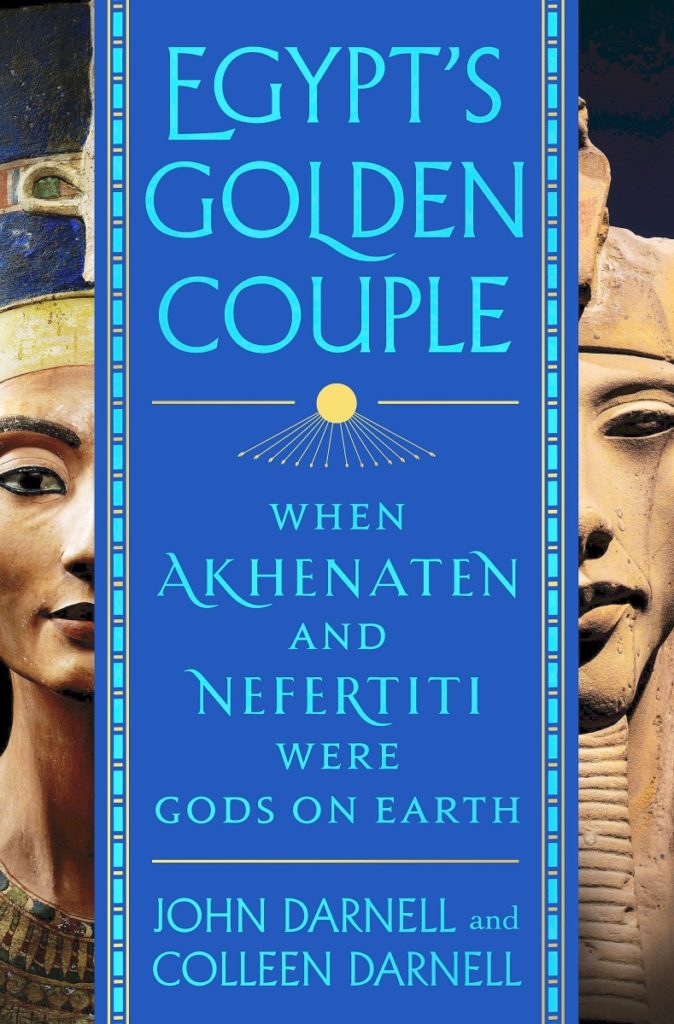
Dr John Coleman Darnell and Dr Colleen Darnell,
photographed in their home by Jennifer Schulten.
On November 4, 1922, 100 years to the date of this publication, Tutankhamen’s tomb was discovered, cementing the young pharaoh and the excavation in worldwide imagination and popular culture. But what about his parents? Yale Egyptologists Drs John Coleman Darnell and Colleen Darnell recently released Egypt’s Golden Couple: When Akhenaten and Nefertiti Were Gods On Earth, a new study of these revolutionary co-rulers. In Egypt’s Golden Couple, the Darnells combine scholarship and detective investigation to piece together the story of Akhenaten and Nefertiti’s reign. Antiques and The Arts Weekly corresponded with John and Colleen via email to learn more.
When were you first seized by the wonders of Ancient Egypt?
John: My interest really began with my mother, who herself had an interest in archaeology since she was a girl, who would read to me, hoping to lull me to sleep, but instead, I was just fascinated by the stories of the ancient world and refused to actually nap. I then pursued degrees in Egyptology at the Johns Hopkins University, University of Cologne and the Oriental Institute of the University of Chicago. I started an expedition mapping ancient desert routes and recording the associated archaeological and epigraphic material in 1992 and have been working in the Western and Eastern deserts of Egypt ever since.
Colleen: My fascination with ancient Egypt also goes back to when I was a child and voraciously read about ancient history. I was consumed with the desire to learn to read hieroglyphs, and I received my BA and PhD in Egyptology at Yale University to do just that. I have been fortunate to work in museum collections around the world, to direct my own archaeological expedition at the site of Moalla, and also participate in expeditions that John directs.
What inspired you to write a new biography about Akhenaten and Nefertiti?
Colleen: A great deal of our work over the past several years has intersected with the reign of Akhenaten and Nefertiti. In 2007, John and I co-authored Tutankhamun’s Armies: Battle and Conquest in Ancient Egypt’s Late 18th Dynasty, which focused on the military history of Akhenaten and Tutankhamun’s reigns. So that entailed a lot of research into the history of the period. Many of our publications have focused on Egyptian solar religion, particularly as expressed in funerary literature. So, it was a perfect fusion of topics to return to Akhenaten, explore his relationship with Nefertiti more deeply, and present new theories about the changes he made to Egyptian religious practice.
Why do you believe that the public continues to be fascinated by Ancient Egypt?
The phenomena of Egyptian revival designs and Egyptomania more broadly is so widespread that it is difficult to find a single reason for the popularity of Ancient Egypt. The massive size of ancient Egyptian monuments and their incredible preservation is certainly a major factor, as well as the incredible number of artifacts that have survived for thousands of years. Even the ancient Greeks and Romans and medieval Arab writers believed that Egypt was the land of wisdom and sacred mysteries – and certainly that reputation persists to this day. Of course, the golden treasures in the tomb of Tutankhamun added fuel to the fires of Egyptomania, although Egyptian themes were already popular in the first two decades of the Twentieth Century, particularly for new forms of architecture, such as movie palaces.

Courtesy of St. Martin’s Press.
Who is your target audience for Egypt’s Golden Couple?
From start to finish, we wrote Egypt’s Golden Couple for everyone – with enough context so that someone with no background in Egyptian history could follow the story, but with enough detail that readers who already know about the topic will be surprised and learn something new. We believe strongly that an important aspect of being an academic is to present the results of new research to the widest possible audience.
Your book investigates the polarized views of Akhenaten and illustrates Nefertiti as far more than her portrait bust. What would you like people to know most about this couple that has not yet been discovered?
We would most like people to know that it is impossible to understand Akhenaten without also exploring the role of Nefertiti and vice versa. What they accomplish in their changes to religion, building a new capitol and new styles of art, they can only do together. Akhenaten and Nefertiti harness creation myths, identifying as the first male-female pair, to change what it means to be a king and queen.
Are there any upcoming projects in your busy schedules that you could share with us?
We are currently working on academic publications of our archaeological work, including the complete study of the rock inscription site of El Khawy where, in 2017, we found the earliest monumental hieroglyphic inscription dating to circa 3250 BCE. It was one of the top ten discoveries of the year in Archaeology Magazine.
Editor’s Note: Egypt’s Golden Couple: When Akhenaten and Nefertiti Were Gods on Earth is available from St Martin’s Press in print and e-book formats. For information, www.us.macmillan.com/stmartinspress/.
– Z.G. Burnett




